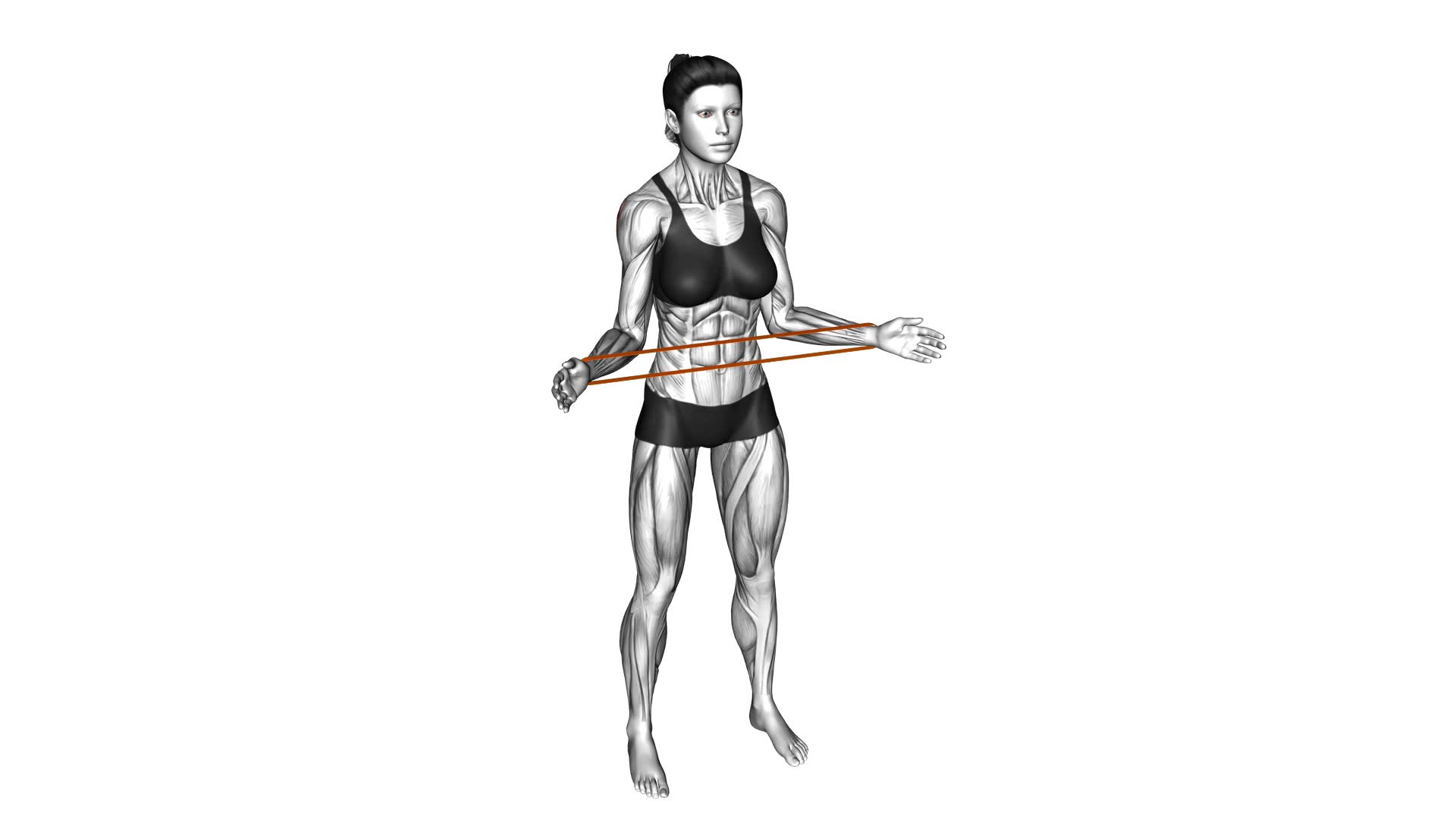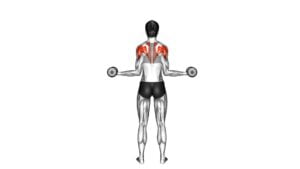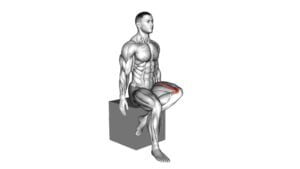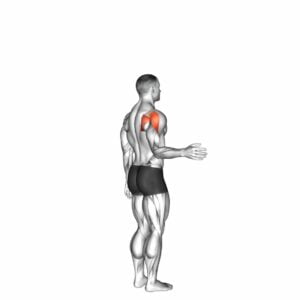Resistance Band Standing External Rotation (female) – Video Exercise Guide & Tips

Are you looking for an effective exercise to strengthen your shoulders?
Watch This Exercise Video
Look no further than the resistance band standing external rotation!
This exercise targets the muscles in your shoulders and helps improve stability and range of motion.
With our video exercise guide and helpful tips, you'll learn the proper technique and avoid common mistakes.
Get ready to increase the intensity of your workout and achieve your fitness goals.
Let's get started!
Key Takeaways
- Resistance band standing external rotation targets and strengthens muscles of the shoulders and upper back.
- This exercise improves shoulder stability, range of motion, and corrects muscle imbalances, leading to improved posture.
- The exercise engages and activates the muscles of the rotator cuff, reducing the risk of rotator cuff injuries and increasing shoulder stability and strength.
- It is important to choose the appropriate resistance band and tension level, maintain proper form and technique, and gradually increase intensity to maximize the benefits of the exercise.
Benefits of Resistance Band Standing External Rotation
You can experience several benefits by incorporating resistance band standing external rotation exercises into your workout routine. These exercises are highly effective in targeting and strengthening the muscles of your shoulders and upper back. By regularly performing resistance band standing external rotations, you can improve your shoulder stability and range of motion, which can be particularly beneficial for athletes involved in throwing or overhead activities.
Additionally, these exercises can help correct muscle imbalances and improve posture by strengthening the muscles that retract and externally rotate the shoulders. This can help alleviate shoulder pain and discomfort caused by poor posture.
Resistance band standing external rotation exercises are also a great way to engage and activate the muscles of your rotator cuff, which play a crucial role in shoulder stability and injury prevention. By incorporating these exercises into your routine, you can strengthen these muscles and reduce the risk of rotator cuff injuries.
Proper Equipment and Set Up for the Exercise
To ensure a successful resistance band standing external rotation exercise, it's important to consider three key points.
- Equipment options: First, select the appropriate resistance band for your fitness level and desired intensity. This will ensure that you have the right amount of resistance to challenge your muscles without straining or injuring them.
- Correct band tension: Next, make sure the band is securely anchored to a sturdy object or held by a partner. This will ensure that the band stays in place and provides consistent tension throughout the exercise. It's important to check the tension of the band before starting the exercise to ensure it's not too loose or too tight.
- Ideal exercise positioning: Finally, position yourself in a stable stance with proper alignment to effectively target the muscles and avoid injury. Stand with your feet hip-width apart, knees slightly bent, and core engaged. Keep your back straight and shoulders relaxed. This positioning will help you maintain balance and control throughout the exercise, allowing you to get the most out of each repetition.
Equipment Options
To properly perform the Resistance Band Standing External Rotation exercise, you'll need a suitable piece of equipment. When it comes to resistance band options, there are a few different choices available.
You can opt for a traditional resistance band, which is a long, elastic band that provides varying levels of resistance. These bands come in different colors, each indicating a different resistance level. Alternatively, you can choose a loop resistance band, which is a smaller band that forms a loop and provides resistance when stretched.
Both options are effective for the Standing External Rotation exercise and can be easily incorporated into your workout routine. If you don't have access to resistance bands, there are alternative exercises you can try, such as using dumbbells or cables to perform external rotations.
Remember to choose the option that works best for you and allows you to challenge your muscles safely and effectively.
Correct Band Tension
To ensure proper equipment and set up for the exercise, it's important to regularly check the tension of the resistance band. Band tension refers to the level of resistance provided by the band when stretched. Having the correct band tension is crucial for maximizing the effectiveness of the exercise and avoiding injury.
When setting up for the standing external rotation exercise, choose a resistance band with a tension level that challenges your muscles without causing strain or discomfort. The band should provide enough resistance to make the exercise challenging, but not so much that you struggle to maintain proper form. It's recommended to start with a lighter resistance band and gradually increase the tension as your strength improves.
Regularly checking and adjusting the band tension will help you achieve optimal results and prevent overexertion.
Ideal Exercise Positioning
You should regularly position yourself in the ideal exercise position to ensure proper equipment and set up for the exercise. To achieve the best results and minimize the risk of injury, follow these guidelines:
- Stand with your feet shoulder-width apart to maintain a stable base.
- Hold the resistance band with both hands, ensuring it's securely anchored.
- Keep your back straight and core engaged throughout the exercise.
- Maintain a slight bend in your knees to protect your joints.
When it comes to choosing the right resistance band, opt for bands that provide enough tension to challenge your muscles without straining them. It's recommended to start with a light to medium resistance band and gradually increase the resistance as you progress. This will help you improve your strength and endurance while minimizing the risk of overexertion.
Step-by-Step Guide to Performing the Exercise
To perform the resistance band standing external rotation exercise correctly, it's important to focus on proper form. This includes keeping your upper body stable, engaging your core, and maintaining a slight bend in your knees.
Avoid common mistakes such as using momentum to swing the band or allowing your shoulders to round forward.
Proper Form Tips
Start by positioning yourself with the resistance band anchored at waist height. To ensure proper form and maximize the benefits of the exercise, keep the following tips in mind:
- Maintain a neutral spine throughout the movement to protect your back.
- Engage your core muscles to stabilize your body and prevent any unnecessary movement.
- Keep your shoulder blades down and back to maintain proper shoulder alignment.
- Control the movement by using slow and controlled motions, focusing on the targeted muscles.
By following these form tips, you can perform the resistance band standing external rotation exercise effectively and safely.
Now, let's move on to the next section to learn about common mistakes to avoid during this exercise.
Common Mistakes to Avoid
To avoid common mistakes when performing the resistance band standing external rotation exercise, be mindful of the following key points.
First, make sure to maintain proper posture throughout the exercise. Avoid rounding your shoulders or hunching forward, as this can compromise the effectiveness of the movement and increase the risk of injury.
Additionally, be cautious of using too much resistance. Start with a lighter band and gradually increase the tension as your strength improves. Using excessive resistance can lead to poor form and technique errors.
Lastly, don't rush through the exercise. Take your time to perform each repetition with control and precision. This will ensure that you're targeting the correct muscles and maximizing the benefits of the exercise.
Benefits of Exercise
Begin by securing the resistance band around a stable object at chest height. This exercise offers numerous benefits and is important for strengthening the external rotators of the shoulder. Here are some key benefits of the resistance band standing external rotation:
- Increases shoulder stability and strength
- Improves posture and alignment
- Enhances overall upper body function
- Helps prevent shoulder injuries
By performing this exercise regularly, you can experience improved shoulder mobility, decreased risk of injury, and enhanced performance in daily activities and sports.
Now that you understand the benefits, let's move on to the next section and learn about common mistakes to avoid when performing the resistance band standing external rotation exercise.
Common Mistakes to Avoid
Avoiding common mistakes is crucial for proper execution of the Resistance Band Standing External Rotation exercise. To ensure you get the most out of this exercise and avoid injury, it's important to be aware of the common mistakes that people often make.
One common mistake is using too much resistance or tension in the band. It's important to start with a lighter resistance and gradually increase as you become more comfortable and confident in your form. Using too much resistance can put unnecessary strain on your muscles and joints, increasing the risk of injury.
Another mistake to avoid is improper technique. When performing the external rotation, it's important to keep your elbow close to your body and maintain a stable core. Avoid swinging your arm or using momentum to complete the movement. Instead, focus on isolating the muscles in your shoulder and performing the exercise with controlled movements.
Finally, be mindful of your posture throughout the exercise. Avoid slouching or rounding your shoulders, as this can compromise the effectiveness of the exercise and lead to improper form.
Tips for Increasing the Intensity of the Exercise
To increase the intensity of the Resistance Band Standing External Rotation exercise, you can incorporate different resistance bands with higher levels of tension. Here are some tips for increasing the difficulty and incorporating advanced techniques into this exercise:
- Use a resistance band with a higher tension level: Choose a band that provides more resistance to challenge your muscles and increase the difficulty of the exercise.
- Increase the number of repetitions: Instead of performing the exercise for a set number of repetitions, try increasing the number of reps to push your muscles further and enhance the intensity.
- Slow down the movement: By performing the exercise at a slower pace, you can engage your muscles for a longer duration and increase the difficulty.
- Add a pause at the end of the movement: When you reach the end range of motion, hold the position for a few seconds before returning to the starting point. This pause increases the time under tension and intensifies the exercise.
Incorporating these tips will help you challenge your muscles, improve your strength, and maximize the benefits of the Resistance Band Standing External Rotation exercise. Remember to listen to your body and adjust the intensity according to your fitness level.
Variations and Modifications for Different Fitness Levels
To cater to different fitness levels, it's essential to provide variations and modifications for the Resistance Band Standing External Rotation exercise. This exercise targets the muscles of the shoulders and upper back, improving shoulder stability and posture.
For beginners or individuals with limited shoulder mobility, starting with a lighter resistance band or no resistance at all can be beneficial. This allows for proper form and technique while gradually building strength. As you progress, you can increase the resistance of the band or use a thicker band to challenge your muscles further.
Additionally, you can modify the exercise by adjusting your body position. Performing the external rotation exercise in a seated position or with your back against a wall can provide more stability and support.
If you're looking for a more advanced variation, you can try performing the exercise with one arm at a time or incorporating a combination of external rotation and other shoulder exercises.
Remember to always listen to your body and choose the variation or modification that suits your fitness level and goals.
Frequently Asked Questions
Are There Any Specific Exercises or Stretches I Should Do Before Performing the Resistance Band Standing External Rotation?
Before performing the resistance band standing external rotation, it's important to do some preparation exercises and warm up routines. These will help to activate the muscles and increase flexibility, reducing the risk of injury.
If you don't have a resistance band, you can use alternatives like a towel or a theraband. Additionally, you can modify the exercise to suit different fitness levels by adjusting the resistance or range of motion.
How Many Repetitions and Sets Should I Aim for When Doing This Exercise?
When doing the resistance band standing external rotation, it's important to know how many repetitions and sets to aim for.
To maximize muscle burn and progress, it's recommended to start with 2-3 sets of 10-15 repetitions. This will challenge your muscles and help build strength and stability.
As you become more comfortable and stronger, you can gradually increase the number of sets or repetitions.
Remember to listen to your body and adjust the intensity as needed.
Can I Use a Different Type of Resistance Band if I Don't Have the Recommended One?
Yes, you can definitely use a different type of resistance band if you don't have the recommended one. There are various alternatives available that can provide a similar level of resistance. Look for bands with similar tension levels or experiment with different bands to find one that works for you.
The most important thing is to ensure that the band provides enough resistance to challenge your muscles during the exercise.
Is It Normal to Feel a Burning Sensation in the Muscles During the Exercise?
Feeling a burning sensation in your muscles during exercise is normal. It could be a sign that your muscles are working hard and getting stronger.
However, if the burning sensation is accompanied by sharp pain or discomfort, it's important to stop and assess if you're performing the exercise correctly.
Make sure to warm up properly before starting the exercise and incorporate pre-exercise stretches to help prevent muscle soreness and injury.
Can I Incorporate the Resistance Band Standing External Rotation Into a Full-Body Workout Routine?
Yes, you can definitely incorporate the resistance band standing external rotation into a full-body workout routine.
Resistance band exercises are a great way to engage multiple muscle groups and add variety to your workouts. They provide resistance throughout the entire range of motion, helping to strengthen and tone your muscles.
Adding this exercise to your routine can help improve shoulder stability and strengthen the muscles in your upper back.
Conclusion
In conclusion, the resistance band standing external rotation is a beneficial exercise for strengthening the muscles in the shoulders and upper back. By using proper equipment and following the step-by-step guide, you can perform this exercise effectively.
Avoid common mistakes and use the tips provided to increase the intensity of the exercise. Additionally, variations and modifications are available to suit different fitness levels.
Incorporate this exercise into your workout routine to improve your overall upper body strength and stability.

Author
Years ago, the spark of my life’s passion ignited in my mind the moment I stepped into the local gym for the first time. The inaugural bead of perspiration, the initial endeavor, the very first surge of endorphins, and a sense of pride that washed over me post-workout marked the beginning of my deep-seated interest in strength sports, fitness, and sports nutrition. This very curiosity blossomed rapidly into a profound fascination, propelling me to earn a Master’s degree in Physical Education from the Academy of Physical Education in Krakow, followed by a Sports Manager diploma from the Jagiellonian University. My journey of growth led me to gain more specialized qualifications, such as being a certified personal trainer with a focus on sports dietetics, a lifeguard, and an instructor for wellness and corrective gymnastics. Theoretical knowledge paired seamlessly with practical experience, reinforcing my belief that the transformation of individuals under my guidance was also a reflection of my personal growth. This belief holds true even today. Each day, I strive to push the boundaries and explore new realms. These realms gently elevate me to greater heights. The unique combination of passion for my field and the continuous quest for growth fuels my drive to break new ground.







